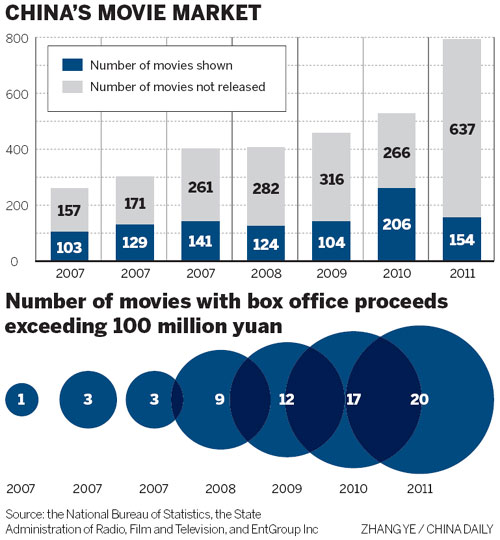Both China Daily ("China's movie sector becomes 2nd-largest") and The Economist ("The filmindustry-Themonkey and the mouse") reported that China surpassed Japan and became the world's second largest film market after U.S. about a year ago – in the first quarter of 2012.
 |
Cinema screens increased from 4,753 in 2006 to 10,700 in 2011:
an average of eight screens per day. “No nation in the world grew
at that fast pace", as referred by Mike Ellis the Asia-Pacific
president of the Motion Picture Association of America.
Economist's Point Of View
The speed of growing dropped down
for the year of 2012, but not the growth. It is still much far from slowing
down from an economist’s point of view.
U.S., the oldest biggest film
market contributes stably 0.4% of total national GDP almost every year from the
past 13 years. Even though this industry has a name of – and is indeed of –
high risk and unpredictable outcome, the fluctuation of the value added by the
film industry as a percentage of GDP has been very small – 0.1% up or down, making
its contribution to the biggest economy of the world between 0.3% to 0.5%.
What about China's GDP?
Since the National Bureau of
Statistics of China’s GDP data is not accessible (due to its website technology
failure), I had to look for corresponding statistics from others sources, and
please bear with me for the dated data: According to an article from China Economic Herald, the Chinese
motion picture industry weighs only 0.075% in the tertiary sector, and contributes
only 0.032% to the overall GDP of China(Original quote “2009年我国电影产值占第三产业比重仅为0.075%,对GDP的贡献率仅为0.032%,对GDP的拉动率为0.0028%,是第三产业中一个并不太重要的行业。”).
As we learned in the first
paragraph that there had been a 35% increase in the Chinese box-office, so
before the 35% increase, the contribution to overall GDP was 12.5 times less
than what motion picture industry averagely contributes to U.S.
Now, let’s do some simple math.
As more than half (58%) of the overall
film revenue in China generates from the box office gross. Let’s first assume
the overall revenue for the motion picture industry is exactly 35%, and not
even considering China’s overall 8.8% of GDP growth. Then after the change, the
overall contribution to GDP becomes (1+35%)*0.032%=0.043%. Great, so the gap
between U.S. and China is less than 10 times.
Even with a 20% increase or decrease in other aspects of the
film industry revenue, which means the number will change to (1+55%)*0.032%= 0.0496%
or (1+15%)$0.032%=0.0368, the Chinese film industry is still far from
contributing.
What is the logic behind this comparison? The potential. The future. The should-be scale of the Chinese film market.
What is the logic behind this comparison? The potential. The future. The should-be scale of the Chinese film market.
Merging of the International Market
As China already became the second
biggest market for box office, there is still ten times of space without
exploring other aspects. Why should not Hollywood be excited? But the reasons
that are driving DreamWorks, Disney, Warner Brothers into this land are much
stronger than just a simple rationing based on the healthy category. I
will get into the different details in my future pieces, so keep an eye on it if you find it interesting, but before that, I will insert an exciting analysis on how to market a $3 million small-budget film to make $200 million box office revenue in China next time.




No comments:
Post a Comment